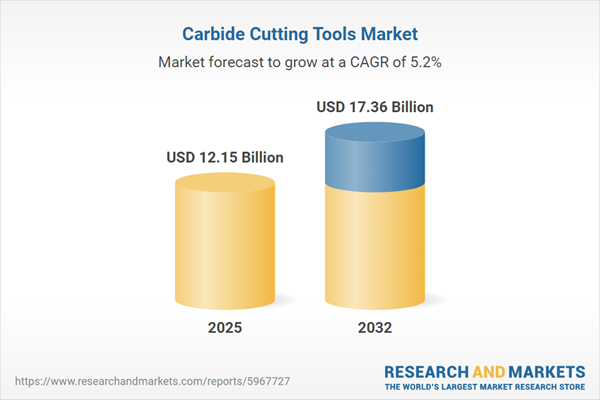Speak directly to the analyst to clarify any post sales queries you may have.
The Carbide Cutting Tools Market is undergoing dynamic transformation, driven by advances in materials, manufacturing technology, and strategic shifts from leading industry participants. As competitive pressures and evolving end-user needs reshape the global precision machining landscape, industry leaders require actionable insights for sustained success.
Market Snapshot: Carbide Cutting Tools Market Performance
The carbide cutting tools market demonstrated steady growth, increasing from USD 11.60 billion in 2024 to USD 12.15 billion in 2025. A compound annual growth rate (CAGR) of 5.17% is projected, with market value expected to reach USD 17.36 billion by 2032. This expansion reflects heightened demand across industries such as aerospace, automotive, and medical manufacturing, alongside rapid technology integration and supply chain adaptation.
Scope & Segmentation
This comprehensive report covers deep segmentation and regional analysis to clarify core opportunities and challenges:
- Tool Types: Drills, End Mills, Inserts, Reamers, Taps
- Material Types: Silicon Carbide, Tantalum Carbide, Titanium Carbide, Tungsten Carbide
- Manufacturing Processes: Brazed Carbide Tools, Sintered Carbide Tools, Solid Carbide Tools
- Coating Types: Coated, Uncoated
- Distribution Channels: Offline, Online
- End Use Industries: Aerospace, Automotive, Manufacturing, Medical
- Geographic Coverage: North America (United States, Canada, Mexico), Latin America (Brazil, Argentina, Chile, Colombia, Peru), Europe (United Kingdom, Germany, France, Russia, Italy, Spain, Netherlands, Sweden, Poland, Switzerland), Middle East (United Arab Emirates, Saudi Arabia, Qatar, Turkey, Israel), Africa (South Africa, Nigeria, Egypt, Kenya), Asia Pacific (China, India, Japan, Australia, South Korea, Indonesia, Thailand, Malaysia, Singapore, Taiwan)
- Companies Profiled: Accusharp Cutting Tools Pvt. Ltd., CERATIZIT S.A., Diager, EMUGE-Werk Richard Glimpel GmbH & Co. KG, FRAISA SA, Fullerton Tool Company Inc., Guhring, Inc., Hannibal Carbide Tool, Inc., Ingersoll Rand Inc., Kennametal Inc., KORLOY Inc., Kyocera Corporation, Makita Corporation, MAPAL Dr. Kress KG, Mitsubishi Corporation, MOLDINO Tool Engineering, Ltd., NTK CUTTING TOOLS Co., Ltd., OSG Corporation, Sandvik AB, Sumitomo Corporation, TaeguTec LTD., Tungaloy Corporation, UNION TOOL Co., Widia by Kennametal Inc., ZhuZhou Otomo Tools & Metal Co.,Ltd
Key Takeaways for Senior Decision-Makers
- Demand for carbide cutting tools is rising as sectors such as aerospace and precision medical manufacturing require higher efficiency, accuracy, and durability.
- Technological progress—particularly in powder metallurgy, advanced coatings, and smart tooling—enables manufacturers to achieve higher cutting performance and lower operational costs.
- Sustainability initiatives are fostering adoption of recyclable materials and eco-friendly coatings, as environmental standards tighten globally.
- Automation and digital manufacturing, core to Industry 4.0, are accelerating predictive maintenance, adaptive wear compensation, and performance-based service offerings.
- Regional production strategies and expanded inventories help organizations manage geopolitical uncertainties, bolster supply chain resilience, and reduce lead time volatility.
Tariff Impact: Navigating Policy Shifts in the Carbide Cutting Tools Sector
Recent U.S. tariffs have heightened sourcing complexity and input costs for core materials. In response, global manufacturers have adopted capacity expansion in North America, developed cost-optimized material blends, and supplemented supply chains through domestic stockpiling and long-term contracts. These changes are fostering alliances and hybrid operating models, balancing local and international resources to maintain competitiveness and comply with regulatory frameworks.
Methodology & Data Sources
The analysis is grounded in a combination of primary interviews with industry executives, engineers, and supply chain managers, complemented by a thorough review of technical journals, regulatory filings, and patent literature. Cross-verification and triangulation methods ensured valid, high-quality insights into the carbide cutting tools market.
Why This Report Matters for Strategic Planning
- Provides in-depth segmentation and regional insights to aid in market entry or expansion strategies, supporting targeted investment decisions.
- Identifies critical technology adoption trends, sustainability imperatives, and evolving end-use demands that shape competitive advantage.
- Highlights adaptive strategies to manage trade policy impacts and secure operational continuity in a shifting global environment.
Conclusion
The carbide cutting tools market is evolving quickly, demanding continual innovation and supply chain adaptability. Companies that align digital integration, material advancements, and regional flexibility will be best positioned for long-term value creation and resilience in global manufacturing.
Additional Product Information:
- Purchase of this report includes 1 year online access with quarterly updates.
- This report can be updated on request. Please contact our Customer Experience team using the Ask a Question widget on our website.
Table of Contents
3. Executive Summary
4. Market Overview
7. Cumulative Impact of Artificial Intelligence 2025
Companies Mentioned
The companies profiled in this Carbide Cutting Tools market report include:- Accusharp Cutting Tools Pvt. Ltd.
- CERATIZIT S.A.
- Diager
- EMUGE-Werk Richard Glimpel GmbH & Co. KG
- FRAISA SA
- Fullerton Tool Company Inc.
- Guhring, Inc.
- Hannibal Carbide Tool, Inc.
- Ingersoll Rand Inc.
- Kennametal Inc.
- KORLOY Inc.
- Kyocera Corporation
- Makita Corporation
- MAPAL Dr. Kress KG
- Mitsubishi Corporation
- MOLDINO Tool Engineering, Ltd.
- NTK CUTTING TOOLS Co., Ltd.
- OSG Corporation
- Sandvik AB
- Sumitomo Corporation
- TaeguTec LTD.
- Tungaloy Corporation
- UNION TOOL Co.
- Widia by Kennametal Inc.
- ZhuZhou Otomo Tools & Metal Co.,Ltd
Table Information
| Report Attribute | Details |
|---|---|
| No. of Pages | 183 |
| Published | November 2025 |
| Forecast Period | 2025 - 2032 |
| Estimated Market Value ( USD | $ 12.15 Billion |
| Forecasted Market Value ( USD | $ 17.36 Billion |
| Compound Annual Growth Rate | 5.1% |
| Regions Covered | Global |
| No. of Companies Mentioned | 26 |









